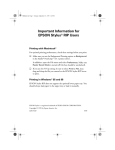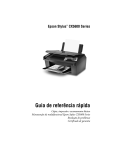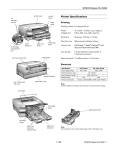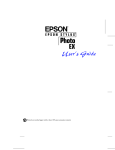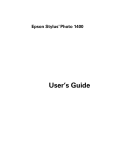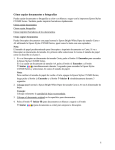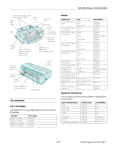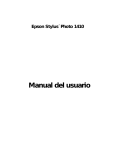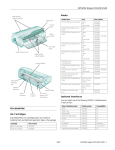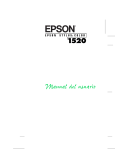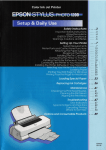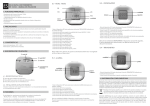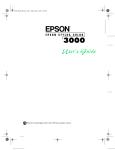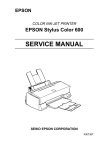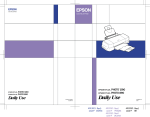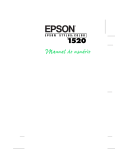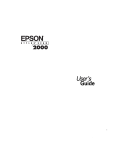Download Stylus Pro 5000
Transcript
Important Information for EPSON Stylus® RIP Users Printing with Macintosh® For optimal printing performance, check these settings before you print: ❑ Make sure you set the Background Printing option to Background in the Adobe® PostScript™ 8.5.1 printer driver. In addition, open the File menu and select Preferences. Make sure Raster Spool Mode is turned off (the box should be unchecked). ❑ If you use the N-Up setting, be sure to select Print to File, then drag and drop the file you created to the EPSON Stylus RIP Server to print. Printing in Windows® 95 and 98 EPSON Stylus RIP does not support the optional lower paper tray. You should always load paper in the upper tray or load it manually. EPSON Stylus is a registered trademark of SEIKO EPSON CORPORATION. Copyright © 1999 by Epson America, Inc. CPD 9387 9/99 SP5000_Supplement.book Page iii Thursday, September 2, 1999 2:49 PM Contents About This Supplement Macintosh System Requirements Windows System Requirements Year 2000 Ready Where To Get Help Setting Up Your Printer EPSON USB/Parallel Adapter EPSON Stylus RIP Aligning the Print Head Connecting Your Printer with the EPSON USB/Parallel Adapter Installing Your Software Uninstalling Your Software Configuring for a Network Macintosh Users Windows 98 Users Options and Consumables EPSON Type B IEEE-1394 (FireWire) Interface Card EPSON RS-5000 Fiery® LX RIP EPSON Type B 10BaseT/100BaseTX Ethernet Interface Card EPSON Professional Quality Media Print Engine Memory Buffer iii 1 2 3 4 4 6 6 6 7 8 9 11 12 12 13 16 16 16 16 17 17 SP5000_Supplement.book Page 1 Thursday, September 2, 1999 2:49 PM About This Supplement This Supplement provides information not included in the EPSON Stylus® Pro 5000 Setup Guide and Reference Guide. It contains: • New system requirements for your computer • Where to get help if you need technical support • Descriptions of the EPSON® USB/Parallel Adapter and EPSON Stylus RIP that come with your printer • New print head alignment tips for accurate, clean printouts • Instructions on how to connect the printer to your Macintosh® with the EPSON USB/Parallel Adapter and install your non-PostScript printer driver • Instructions on how to connect to a network with Macintosh and Microsoft® Windows® 98 • Additional options and consumables See your Setup Guide and Reference Guide for detailed information about setting up your printer, using the EPSON driver and utilities, printing on special media, troubleshooting, and maintaining your printer. 1 SP5000_Supplement.book Page 2 Thursday, September 2, 1999 2:49 PM Macintosh System Requirements To use your printer with a Macintosh in either a standalone or network environment as a print server, your system should meet the following minimum requirements: • Power Macintosh ® G3 series (System 8.5.1 or later) or iMac™ series (System 8.1 or later) NOTE: If your iMac is running OS 8.1, you need to update your operating system before installing your printer software. Download and install the iMac Update 1.0 or later from Apple® at http:// swupdates.info.apple.com. Contact Apple if you have problems installing the update. If your iMac is running OS 8.5 or 8.5.1, do not install iMac Update 1.0. Instead, Apple recommends that you download and install iMac Update 1.1. To find out which operating system your iMac is running, select About This Computer in the Apple menu. 2 • At least 16MB of available RAM for the EPSON Stylus RIP software (20MB or more is recommended), in addition to the RAM needed by your operating system and other applications. • At least 52MB of free hard disk space to install the software and at least 150MB of hard disk space for processing large files • CD-ROM drive • USB, FireWire,® Serial, or Ethernet connection to the printer SP5000_Supplement.book Page 3 Thursday, September 2, 1999 2:49 PM To set up a Macintosh as a client on a network using the EPSON Stylus RIP, your system must have the following minimum configuration: • Macintosh Centris,® Macintosh Quadra,® Performa,® Power Macintosh G3 series, or iMac series • Ethernet AppleTalk® connection to the Macintosh set up as the EPSON Stylus RIP print server • 16MB RAM (32MB or more recommended) • At least 2MB of free hard disk space to install the software and at least 150MB of free hard disk space for processing large files • Macintosh System 7.6.1 or later • CD-ROM drive Windows System Requirements To use your printer in either a standalone or peer-to-peer network environment, your system should include: • IBM®-compatible PC with 486 or higher processor (Pentium ® 133 MHz or higher recommended) • Windows 3.1, 95, 98, or NT 4.0 NOTE: EPSON Stylus RIP is not supported in Windows 3.1. • At least 16MB of RAM (32MB or more recommended) • At least 50MB of free hard disk space to install the software and at least 150MB of free hard disk space for processing files (more for large files) • CD-ROM drive • An available parallel port configured as LPT1 3 SP5000_Supplement.book Page 4 Thursday, September 2, 1999 2:49 PM Year 2000 Ready Your printer is Year 2000 Ready. However, be sure the other parts of your computer system are also ready for the year 2000. Where To Get Help EPSON provides technical support and information on installation, configuration, and operation of professional graphics arts products through the EPSON Preferred™ Protection Plan. Dial (888) 377-6611, 6 AM to 8 PM, Pacific Time, Monday through Friday, and 7 AM to 4 PM, Pacific Time, Saturday and Sunday. Weekend support hours are subject to change without notice. If you have problems accessing the support line, call (562) 276-1305 in the U.S. or (905) 709-2567 in Canada. Toll or long distance charges may apply. Before you call, make sure you have your Unit ID number, which is included with the EPSON Preferred Protection Plan that comes with your printer. 4 SP5000_Supplement.book Page 5 Thursday, September 2, 1999 2:49 PM EPSON also provides customer support through the following services: Electronic support services Service Access World Wide Web From the Internet, you can reach EPSON’s Home Page at http://www.epson.com. EPSON Internet FTP Site If you have Internet FTP capability, use your Web browser (or other software for FTP downloading) to log onto ftp.epson.com with the user name anonymous and your e-mail address as the password. EPSON Forum on CompuServe® Members of CompuServe can type GO EPSON at the menu prompt to reach the Epson America Forum. For a free introductory CompuServe membership, call (800) 848-8199 and ask for representative #529. Automated telephone services Service Access EPSON SoundAdviceSM For recorded answers to commonly asked questions about EPSON products 24 hours a day, seven days a week, call (800) 922-8911. EPSON FaxAdviceTM Access EPSON’s technical information library by calling (800) 922-8911. You must provide a return fax number to use this service. EPSON Referral Service For the location of your nearest Authorized EPSON Reseller or Customer Care Center, call (800) 922-8911. You can purchase ink cartridges, paper, manuals, and accessories from EPSON Accessories at (800) 873-7766 (U.S. sales only). In Canada, please call (800) 873-7766 for dealer referral. 5 SP5000_Supplement.book Page 6 Thursday, September 2, 1999 2:49 PM Setting Up Your Printer To unpack and set up your printer, see Chapter 2, “Getting Started,” in your Setup Guide. In addition, you should also have the EPSON USB/Parallel Adapter and EPSON Stylus RIP included in the box. EPSON USB/Parallel Adapter The EPSON USB/Parallel Adapter allows you to use smart cable technology to connect your EPSON printer to the Macintosh. Follow the instructions on page 8 to connect the USB/Parallel Adapter to your Macintosh. EPSON Stylus RIP The EPSON Stylus RIP software lets you use your EPSON Stylus Pro 5000 as an Adobe ® PostScript® 3™ (Windows NT® 4.0 and Macintosh) and PostScript Level 2 (Windows 95 and 98) compatible printer. It reads the Adobe PostScript files automatically created by the EPSON Stylus RIP printer driver, seamlessly converts them into raster images, and automatically prints them on your printer. In many cases, you may not need the ability to print in PostScript, and for these occasions you should use the standard, non-PostScript driver that comes with your printer. Using the standard driver is also a good way to ensure that your computer and printer are connected and working properly. See your EPSON Stylus RIP User’s Guide that comes with the EPSON Stylus RIP for more information. 6 SP5000_Supplement.book Page 7 Thursday, September 2, 1999 2:49 PM Aligning the Print Head After you have unpacked and set up your printer, you need to run a print check and align the print head. To use the utility from your printer software, see pages 8-37 through 8-41 in your Reference Guide. To use the control panel, see pages 6-4 through 6-7 in your Reference Guide. NOTE: If you experience banding at 720 dpi, run the print head alignment utility several times to improve results. For optimal printing and to avoid banding, follow these tips: • Do not use plain paper when you align the print head; only use high-quality EPSON media • Use a loupe to view the printed lines when determining which set is vertically aligned • You may need to align the print head up to six times to achieve the best results 7 SP5000_Supplement.book Page 8 Thursday, September 2, 1999 2:49 PM Connecting Your Printer with the EPSON USB/Parallel Adapter To connect your printer to your PC with a parallel cable, see “Connecting the Printer to Your PC” on page 2-9 in your Setup Guide for instructions. To connect your computer and printer with the EPSON USB/Parallel Adapter, follow the steps below. You can connect your printer directly to a port on your computer or to a USB hub. If you have any printing problems when the printer is connected via a USB hub, try connecting the printer directly to the computer instead. 1. Turn off the printer and computer. 2. To connect to a Power Macintosh G3, connect the USB/Parallel Adapter into an available USB port on the back of your computer. To connect to an iMac, first open the port door. Hold the cable so the icon faces up and then plug the connector into an available USB port. If you’re using a USB hub, plug the hub into the USB port on your computer, then plug the USB end of the EPSON USB/Parallel Adapter into an available port on the hub. If you have more than one hub, connect the EPSON USB/Parallel Adapter into the first hub. To connect the EPSON USB/Parallel Adapter to one of the USB ports on the keyboard, hold the USB connector so the icon faces away from you and plug it into the USB port. 3. Connect the parallel end of the cable to the printer’s parallel connector, then fasten it with the wire clips. 8 SP5000_Supplement.book Page 9 Thursday, September 2, 1999 2:49 PM Installing Your Software To install your non-PostScript printer driver in Windows 98, see “Installing the Printer Software in Your PC” on page 2-10 in your Setup Guide for instructions. The instructions apply to both Windows 95 and 98. Follow the steps below to install your non-PostScript printer driver on a Macintosh using the EPSON USB/Parallel Adapter. NOTE: If your iMac is running OS 8.1, you need to update your operating system before installing your printer software. Download and install the iMac Update 1.0 or later from Apple at http:// swupdates.info.apple.com. Contact Apple if you have problems installing the update. If your iMac is running OS 8.5 or 8.5.1, do not install iMac Update 1.0. Instead, Apple recommends that you download and install iMac Update 1.1. To find out which operating system your iMac is running, select About This Computer in the Apple menu. 1. Make sure your printer and computer are connected and turned off. 2. Turn on your computer and wait until you see the icons on your desktop. 3. Turn on your printer and wait until the green P Operate light stops flashing. 4. Insert the printer software CD-ROM in your drive. 5. Double-click the EPSON Installer icon. 6. At the printer driver installation screen, click Continue. 9 SP5000_Supplement.book Page 10 Thursday, September 2, 1999 2:49 PM 7. Click Install, then follow the on-screen instructions to install the printer driver and select a default paper size. 8. After installation is complete, click Restart to restart your computer. 9. Open the Chooser from the Apple menu. 10. Click the icon. 11. Select the USB Port icon (if you’ve connected more than one printer, the port is numbered). select a USB Port 12. Turn on background printing if you want, then close the Chooser. If you don’t see your printer icon in the Chooser, make sure your USB port and printer parallel port connections are secure and your printer is turned on. If you still have problems, check the documentation that came with your computer for help. If the printer doesn’t work correctly, uninstall the printer software as described in the next section. Make sure the EPSON USB/Parallel Adapter is securely connected, then reinstall the EPSON printer software as described on page 9. If you still have problems, contact your EPSON dealer or EPSON technical support as described in “Where To Get Help” on page 4. 10 SP5000_Supplement.book Page 11 Thursday, September 2, 1999 2:49 PM Uninstalling Your Software To uninstall your non-PostScript printer driver in Windows 98, follow the instructions in “Uninstalling the Printer Software (Windows 95)” on page 8-42 in your Reference Guide. The instructions apply to both Windows 95 and 98. For Macintosh users, follow these steps: 1. Insert the printer software CD-ROM in your drive. 2. Double-click the EPSON Installer icon. 3. At the printer driver installation screen, click Continue. 4. On the Installer screen, click the arrow in the list showing Easy Install, and select Remove. changes to Remove 5. Click the Remove button at the bottom of the screen. 6. After the software is uninstalled, click Quit on the Installer window, then restart your computer. To reinstall your software, see “Installing Your Software” on page 9. 11 SP5000_Supplement.book Page 12 Thursday, September 2, 1999 2:49 PM Configuring for a Network This section contains information not provided in your Setup Guide or Reference Guide. Before you can use your printer on a network, you must configure your computer as described in this section. Macintosh Users To set up the printer so that you can use it on an AppleTalk network, you need an optional EPSON Ethernet interface card for your printer. You’ll first need to install the printer software on all the computers (see page 9). Then follow these steps: 1. Turn on your printer. 2. Open the AppleTalk Control Panel and choose Ethernet or a specific Ethernet slot. 3. If prompted, click Save. 4. Open the Chooser from the Apple menu and click the icon. 12 SP5000_Supplement.book Page 13 Thursday, September 2, 1999 2:49 PM 5. If you are using AppleTalk zones, select the zone you want to use. A list of all the printers connected to the selected zone appears on the right. Click the name assigned to the EPSON Stylus Pro 5000. click the name assigned to your printer 6. Turn on background printing if you want, then close the Chooser. Windows 98 Users If your computer is on a Windows 98 network and you want other users to share the printer connected to it, you need to set up the system connected to the printer (host system) so the printer can be shared and define a path to the printer on each client computer. Before following the steps in the next section, make sure you’ve installed the printer software on all the computers that will use the printer. See page 2-10 in your Setup Guide for instructions. NOTE: This section describes how to set up your computer to use a directly-connected printer as a shared printer on a network. 13 SP5000_Supplement.book Page 14 Thursday, September 2, 1999 2:49 PM Setting Up the Host System 1. Click Start, point to Settings, and select Control Panel. 2. Double-click Network, then click the File and Print Sharing button. 3. Click the I want to be able to allow others to print to my printer(s) checkbox and click OK. 4. In the Network window, click OK. NOTE: If a dialog box requesting the Windows 98 CD-ROM appears, insert the CD-ROM in the drive, then follow the on-screen messages. If a dialog box appears requesting you to restart your computer, do so. Then continue with step 5. 5. In the Control Panel, double-click Printers. 6. Right-click the EPSON Stylus Pro 5000 icon, then click Sharing on the File menu. 7. Click the Shared As radio button. Then enter a Share Name, Comment, and Password as necessary, and click OK. 14 SP5000_Supplement.book Page 15 Thursday, September 2, 1999 2:49 PM Setting Up Client Systems 1. Click Start, point to Settings, and select Printers. 2. Right-click the EPSON Stylus Pro 5000 icon and choose Properties. 3. Click the Details tab. 4. Click the Add Port button, then click Browse to specify the network path to the printer. NOTE: To print from DOS applications as well as Windows applications, click the Capture Printer Port button instead of Add Port. Select the printer port in the Device list, then specify its network path. Select Reconnect at logon, then click OK. 5. When you return to the Details tab, click OK. 15 SP5000_Supplement.book Page 16 Thursday, September 2, 1999 2:49 PM Options and Consumables This section describes options not listed in your Setup Guide. EPSON Type B IEEE-1394 (FireWire) Interface Card This interface card (C823722) provides up to a 400 Mbps data transfer rate between your Macintosh and high-speed devices. It also features automatic configuration, and eliminates any need to turn off or restart your Macintosh when attaching a new device. Based on the print engine performance, there will not be a significant performance difference between the FireWire, USB, serial, or parallel interfaces. EPSON RS-5000 Fiery® LX RIP EPSON and EFI® have joined forces to offer an optional standalone Fiery LX RIP (C850071) for the EPSON Stylus Pro 5000. It gives you the power to simultaneously spool, RIP, and print jobs over your entire network, plus complete WebTools™ and sophisticated color management. EPSON Type B 10BaseT/100BaseTX Ethernet Interface Card The EPSON Type B 10BaseT/100BaseTX Ethernet Interface Card (C823632) allows you to connect your EPSON printer directly to a network. 16 SP5000_Supplement.book Page 17 Thursday, September 2, 1999 2:49 PM EPSON Professional Quality Media EPSON papers are your best choice for everyday printing, including presentations, graphic arts comps and layouts, professional-level digital photography, and fine art printing. Refer to the Setup Guide and Reference Guide for a complete list. For use in prefilm proofing, the best choice is DuPont®/EPSON Professional Proofing Paper. With the support of a RIP, these papers simulate the texture and background color of popular printing stocks. • DuPont/EPSON Commercial Grade Stock—Bright White Glossy S041160 Super B Size (13 × 19 inches, 100 sheets) • DuPont/EPSON Commercial Grade Stock—Matte Super B Size (13 × 19 inches, 100 sheets) S041203 Super B Size (13 × 19 inches, 20 sheets) S041201 • DuPont/EPSON Publication Super B Size (13 × 19 inches, 100 sheets) Super B Size (13 × 19 inches, 20 sheets) S041207 S041205 Print Engine Memory Buffer The standard buffer provides 64KB of memory and is upgradeable to 96MB. It uses standard 70ns SIMMs Fast Page Mode only (three available slots). Any extra memory buffer can be used for client-free printing of multiple copies only. However, not all resolutions support multiple-copy mode. Memory for the EPSON Stylus Pro 5000 is not available through EPSON; contact your reseller for information. 17 SP5000_Supplement.book Page 18 Thursday, September 2, 1999 2:49 PM Trademarks EPSON and EPSON Stylus are registered trademarks of SEIKO EPSON CORPORATION. EPSON SoundAdvice is a service mark and DX3, EPSON FaxAdvice, and SelecType are trademarks of Epson America, Inc. EFI, the EFI logo, Fiery, and the Fiery logo are U.S. registered trademarks of Electronics for Imaging, Inc. General Notice: Other product names used herein are for identification purposes only and may be trademarks of their respective owners. EPSON disclaims any and all rights in those marks. Legal Notices Neither SEIKO EPSON CORPORATION nor its affiliates shall be liable to the purchaser of this product or third parties for damages, losses, costs, or expenses incurred by purchaser or third parties as a result of: accident, misuse, or abuse of this product or unauthorized modifications, repairs, or alterations to this product, or (excluding the U.S.) failure to strictly comply with SEIKO EPSON CORPORATION’s operating and maintenance instructions. SEIKO EPSON CORPORATION shall not be liable for any damages or problems arising from the use of any options or any consumable products other than those designated as Original EPSON Products or EPSON Approved Products by SEIKO EPSON CORPORATION. Copyright Notice All rights reserved. No part of this publication may be reproduced, stored in a retrieval system, or transmitted in any form or by any means, electronic, mechanical, photocopying, recording, or otherwise, without the prior written permission of SEIKO EPSON CORPORATION. The information contained herein is designed only for use with this EPSON printer. EPSON is not responsible for any use of this information as applied to other printers. Copyright © 1999 by Epson America, Inc. CPD 9241 18 8/99 Printer Guide ® ® EPSON Stylus Pro 5000 Printed on recycled paper with at least 10% post-consumer content. Copyright © 1998 by Epson America, Inc. All rights reserved. No part of this publication may be reproduced, stored in a retrieval system, or transmitted in any form or by any means, electronic, mechanical, photocopying, recording, or otherwise, without the prior written permission of SEIKO EPSON CORPORATION. The information contained herein is designed only for use with this EPSON printer. EPSON is not responsible for any use of this information as applied to other printers. Trademarks EPSON and EPSON Stylus are registered trademarks of SEIKO EPSON CORPORATION. EPSON SoundAdvice and EPSON FaxAdvice are trademarks of Epson America, Inc. EFI, the EFI logo, Fiery, and the Fiery logo are U.S. registered trademarks of Electronics for Imaging, Inc. General Notice: Other product names used herein are for identification purposes only and may be trademarks of their respective owners. EPSON disclaims any and all rights in those marks. The ENERGY STAR emblem does not represent EPA endorsement of any product or service. Legal Notices Neither SEIKO EPSON CORPORATION nor its affiliates shall be liable to the purchaser of this product or third parties for damages, losses, costs, or expenses incurred by purchaser or third parties as a result of: accident, misuse, or abuse of this product or unauthorized modifications, repairs, or alterations to this product, or (excluding the U.S.) failure to strictly comply with SEIKO EPSON CORPORATION’s operating and maintenance instructions. SEIKO EPSON CORPORATION shall not be liable for any damages or problems arising from the use of any options or any consumable products other than those designated as Original EPSON Products or EPSON Approved Products by SEIKO EPSON CORPORATION. Part Number: CPD-6201 3/98 2 FCC Compliance Statement For United States Users This equipment has been tested and found to comply with the limits for a Class B digital device, pursuant to Part 15 of the FCC Rules. These limits are designed to provide reasonable protection against harmful interference in a residential installation. This equipment generates, uses, and can radiate radio frequency energy and, if not installed and used in accordance with the instructions, may cause harmful interference to radio or television reception. However, there is no guarantee that interference will not occur in a particular installation. If this equipment does cause interference to radio and television reception, which can be determined by turning the equipment off and on, the user is encouraged to try to correct the interference by one or more of the following measures. • Reorient or relocate the receiving antenna. • Increase the separation between the equipment and receiver. • Connect the equipment into an outlet on a circuit different from that to which the receiver is connected. • Consult the dealer or an experienced radio/TV technician for help. WARNING The connection of a non-shielded equipment interface cable to this equipment will invalidate the FCC Certification of this device and may cause interference levels which exceed the limits established by the FCC for this equipment. It is the responsibility of the user to obtain and use a shielded equipment interface cable with this device. If this equipment has more than one interface connector, do not leave cables connected to unused interfaces. Changes or modifications not expressly approved by the manufacturer could void the user’s authority to operate the equipment. For Canadian Users This Class B digital apparatus meets all requirements of the Canadian Interference-Causing Equipment Regulations. Cet appareil numérique de la classe B respecte toutes les exigences du Règlement sur le materiel brouilleur du Canada. 3 Contents Introduction _______________________________________ How To Use Your Manuals 2 Using This Printer Guide 3 Warnings and Cautions 3 Where To Get Help 4 ENERGY STAR Compliance 5 Energy-saving Tips 5 Important Safety Instructions 6 Chapter 1: Setting Up the Printer ___________________ Unpacking the Printer 1-1 Installing the Optional Lower Paper Cassette 1-3 Installing the Paper Tray 1-5 Installing the Ink Cartridges 1-5 Loading Paper 1-8 Running a Printer Check 1-14 Aligning the Print Head 1-15 Chapter 2: Printing on Various Substrates ___________ Selecting a Paper Path 2-1 Using the Standard and Optional Paper Trays 2-2 Setting the Paper Tray Levers 2-3 Paper Tray Tips 2-5 Loading Paper in the Optional Lower Tray 2-6 Using the Front Manual Feed Slot 2-7 Using the Rear Manual Feed Slot 2-8 Printing on EPSON Paper and Film 2-10 Printing Tips for EPSON Media 2-11 vi Table of Contents Chapter 3: Monitoring the Printer ___________________ Responding to the Control Panel Lights 3-1 Clearing Paper Jams 3-3 Chapter 4: Maintaining and Transporting the Printer Running a Cleaning Cycle 4-1 Running a Printer Check 4-2 Replacing an Ink Cartridge 4-3 Cleaning the Paper Paths 4-6 Cleaning the Printer 4-7 Transporting the Printer 4-8 Chapter 5: Troubleshooting ________________________ Diagnosing Problems 5-1 Improving Print Quality 5-2 Solving General Printing Problems 5-4 Solving Paper or Other Substrate Problems 5-5 Appendix A: Switching Paper Trays _________________ Appendix B: Specifications _________________________ Printing B-1 Paper B-2 Ink Cartridges B-5 Mechanical B-6 Electrical B-7 Environmental B-7 Safety Approvals B-7 Interfaces B-8 Parallel interface B-8 Serial interface B-9 Index _____________________________________________ Introduction The EPSON® Stylus® Pro 5000 color ink jet printer is the key component in a revolutionary new digital color proofing system. The printer provides resolutions up to 1440 × 720 dpi and MicroPiezo DX3 print head technology, for unsurpassed image quality with line art and text comparable to imagesetter output. Proprietary ASICs (application-specific integrated circuits) ensure consistent printing and color accuracy from job to job and printer to printer. EPSON’s quick-drying CMYK inks print in rich, vibrant colors on a variety of substrates, from plain papers to proofing grade media. Individual, high-capacity ink cartridges with auto ink-level detection provide increased productivity, east of use, and low per-copy printing costs. The EPSON Stylus Pro 5000’s media handling flexibility lets you print on substrates from 4 × 6 inches up to 13 × 19 inches, including 200 lb card stock. With a standard 250-sheet paper tray and optional 250-sheet cassette, you get uninterrupted performance. Fast print speeds let you print a full bleed, 11 × 17 inch photo quality proof or comp in about 15 minutes. The high performance RIP Station 5000 (RS 5000) PostScript® Level 3 server supports a variety of network configurations and protocols, with full compatibility for Macintosh,® Microsoft® Windows® 95, Windows NT, and UNIX® computers. The EFI Fiery® RIP provides full multitasking for simultaneous spooling, PostScript processing, and printing. Standard base color rendering dictionaries for 3M™ MatchPrint™ III, Fuji® Color-Art, and DuPont® WaterProof simulate analog-quality proofing. 2 How To Use Your Manuals How To Use Your Manuals This guide is part of a set, which also includes the following documentation for users and system administrators: • The Read This First roadmap provides easy-to-follow steps for setting up your printer and RIP and connecting them to your network. • The RS 5000 Setup Guide describes how to unpack the RIP, install user software and printer files from the User Software CD, and set up printing. It also describes how to install printer files from the RS 5000 via the Internet. • The RS 5000 User Guide describes how to set printing options and print to the RS 5000. It includes software instructions for both Windows and Mac OS computers. • The RS 5000 Administrator Guide explains basic configuration and administration of the RIP for the supported platforms and network environments. It also includes guidelines for setting up UNIX, Windows NT, and NetWare® servers to provide PostScript printing services to clients. • The RS 5000 Color Printing Guide provides an introduction to the basics of color theory and printing to the EPSON Stylus Pro 5000. It includes practical color printing tips and application-specific instructions for Macintosh and Windows. • Release Notes provide last-minute product information and workarounds for some of the problems you may encounter. 3 Warnings and Cautions Using This Printer Guide This Guide contains the following information: Chapter 1 explains how to unpack and set up the printer. Chapter 2 gives instructions for printing on a variety of substrates through the available paper paths and for using special EPSON media. Chapter 3 explains what to do when the printer’s control panel lights indicate a paper jam or other problem. Chapter 4 gives instructions for replacing ink cartridges, running print head cleaning cycles, and cleaning and transporting the printer. Chapter 5 provides troubleshooting tips and solutions for any printing problems you may have. Appendix A describes how to switch paper tray covers, if you want to use the optional lower paper tray in the standard paper tray slot. Appendix B provides the technical details on your printer, ink cartridges, and EPSON media. An Index is included at the end of the book. Warnings and Cautions You’ll find this information throughout your manual: • Warnings must be followed carefully to avoid bodily injury. • Cautions must be observed to avoid damage to your equipment. 4 Where To Get Help Where To Get Help EPSON provides technical support and information on the installation, configuration, and operation of professional graphics arts products through the EPSON Preferred Protection Plan. Dial (888) 377-6611, 6 A.M. to 8 P.M., Pacific Time, Monday through Friday, and 7 A.M. to 4 P.M., Pacific Time, Saturday and Sunday. Before you call, make sure you have your Unit ID number, which is included with the EPSON Preferred Protection Plan information that came with your printer. EPSON also provides customer support through the following services: Electronic support services Service Access World Wide Web From the Internet, you can reach EPSON’s Professional Graphics Home Page at http://prographics.epson.com. EPSON Internet FTP Site If you have Internet FTP capability, use your Web browser (or other software for FTP downloading) to log onto ftp.epson.com with the user name anonymous and your e-mail address as the password. EPSON Download Service You can call the EPSON Download Service at (800) 442-2007. Set your communications software to 8 data bits, 1 stop bit, no parity. Modem speed can be up to 28.8 Kbps. EPSON Forum on CompuServe® Members of CompuServe can type GO EPSON at the menu prompt to reach the Epson America Forum. For a free introductory CompuServe membership, call (800) 848-8199 and ask for representative #529. Automated telephone services Service Access EPSON SoundAdvice™ Pre-recorded answers to commonly asked questions about EPSON products 24 hours a day, seven days a week, call (800) 442-2110. EPSON FaxAdvice™ Access EPSON’s technical information library by calling (800) 442-2110. You must provide a return fax number to use this service. EPSON Referral Service For the location of your nearest Authorized EPSON Reseller, call (800) 241-5373. 5 ENERGY STAR Compliance You can purchase ink cartridges, paper and other substrates, manuals, accessories, and parts from EPSON Accessories at (800) 873-7766 (U.S. sales only). In Canada, please call (800) 873-7766 for dealer referral. ENERGY STAR Compliance As an ENERGY STAR Partner, EPSON has determined that this product meets the ENERGY STAR guidelines for energy efficiency. The EPA ENERGY STAR Office Equipment program is a voluntary partnership with the computer and office equipment industry to promote the introduction of energyefficient personal computers, monitors, printers, fax machines, and copiers in an effort to reduce air pollution caused by power generation. Energy-saving Tips Here are a few tips you can use to be even more energy-wise: • If your monitor isn’t ENERGY STAR compliant, turn it off when you’re not using it. • Turn off your computer, printer, and monitor each day when you are done using them. • Use the print preview option in your software so you can catch errors before you print something. • Send e-mail rather than distributing memos. Not only is this faster, but you’ll save paper and storage space too. 6 Important Safety Instructions Important Safety Instructions Before using your printer and RIP, read the following safety instructions to make sure you use the equipment safely and effectively. • Turn off and unplug the printer and RIP before cleaning. Clean with a damp cloth only. Do not spill liquid on the printer or RIP. • Do not place the printer or RIP on an unstable surface or near a radiator or heating vent. • Place the printer and RIP on a flat surface. They will not operate properly if they are tilted or at an angle. • Do not block or cover the openings in the printer’s or RIP’s cabinet or insert objects through the slots. • Use only the type of power source indicated on the label. • Connect all equipment to properly grounded power outlets. Avoid using outlets on the same circuit as photocopiers or air control systems that regularly switch on and off. • Place the printer and RIP near a wall outlet where the plugs can be easily unplugged. • Placez l’imprimante près d’une prise de contacte où la fiche peut être débranchée facilement. • Do not let the power cords become damaged or frayed. • If you use an extension cord, make sure the total ampere rating of the devices plugged into the extension cord does not exceed the cord’s ampere rating. Also, make sure the total of all devices plugged into the wall outlet does not exceed 15 amperes. Use of extension cords is not recommended. • Except as specifically explained in the documentation, do not attempt to service the printer or RIP yourself. • Unplug the printer or RIP and refer servicing to qualified service personnel under the following conditions: If the power cord or plug is damaged; if liquid has entered the printer or RIP; if the equipment has been dropped or the cabinet damaged; if the printer or RIP does not operate normally or exhibits a distinct change in performance. Adjust only those controls that are covered by the operating instructions. 7 Important Safety Instructions Even if you are familiar with other types of printers, be sure to read through the following list of precautions before operating your ink jet printer: • Do not put your hand inside the printer or touch the print head during printing. Do not move the print head by hand. • Under normal circumstances, ink will not leak out of the cartridges. If it does get on your skin, wash it off with soap and water. If it gets in your eyes, flush them immediately with water. • Keep ink cartridges out of the reach of children. • Do not dismantle the ink cartridges or try to refill them. This could result in damage to the print head. • Once you install an ink cartridge, do not remove the cartridge except to replace it with a new one (or transport the printer). • Install the ink cartridge immediately after you remove it from its package. Leaving the cartridge unpacked for a long time before use may result in reduced print quality. • Do not use an ink cartridge beyond the date printed on the cartridge carton. For best results, use up the ink cartridges within six months of installing them. • Do not shake an ink cartridge; this can cause leakage. • Always turn the printer off using the P Operate button. When this button is pressed, the Operate light flashes briefly then goes out. Do not unplug the printer or turn off the power to the outlet until the Operate light is off. • Before transporting the printer, make sure the print head is in the far right position and the ink cartridges have been removed. 1 1-1 Chapter 1: Setting Up the Printer Unpacking the Printer To set up your EPSON Stylus Pro 5000, you need to unpack it and install the paper tray(s) and ink cartridges. Then you need to load paper, run a printer check, and align the print head. This chapter covers the following information: • Unpacking the printer • Installing the optional lower paper cassette • Installing the paper tray • Installing the ink cartridges • Loading paper • Running a printer check • Aligning the print head Unpacking the Printer Here’s what is included in the box: paper size and media type cards printer paper tray ink cartridges 1 1-2 Setting Up the Printer C AUTION : The printer weighs approximately 50 lb. Do not try to lift or carry the printer alone. N OTE : The RS 5000 is packed in a separate box. See the RIP Station 5000 Setup Guide for unpacking and setup instructions. The optional lower paper cassette is also packed in a separate box. TO UNPACK THE PRINTER : 1. Follow the instructions on the Notice Sheet to remove the tape and protective materials. Save all packaging so you can use it if you need to transport the printer later. 2. Locate the printer on a flat, stable surface near a grounded outlet. Do not use an outlet controlled by a wall switch or timer, or the same circuit as a large appliance. This may disrupt the power, which can erase the printer’s memory and damage the power supply. 3. Leave plenty of room in back to access the manual feed slot and enough room in front for removing the paper tray. 4. Do not put the printer: • In an area with high temperature or humidity • In direct sunlight or dusty conditions • Near sources of heat or electromagnetic interference, such as loudspeakers or cordless telephone base units N OTE : Be sure to follow the Safety Instructions in the Introduction. If you purchased the optional lower paper cassette, you need to place the printer on top of it. Follow the instructions in the next section to install the lower cassette. 1 1-3 Installing the Optional Lower Paper Cassette Installing the Optional Lower Paper Cassette The lower paper cassette provides an additional paper source, so you can have two different substrates available for printing at all times. If you didn’t purchase the optional lower cassette, skip to the next section and install the standard paper tray. TO INSTALL THE LOWER CASSETTE : 1. Unpack the cassette and paper tray. Follow the illustrated sheet in the box to remove the tape and protective materials. 2. Place the cassette where you want to use the printer, with the paper tray slot facing forward. 3. Place your printer on top of the cassette as shown: W ARNING : Hold the bottom of the printer at the depression on the sides so your fingers don’t get caught between the printer and the cassette. 1 1-4 4. Setting Up the Printer Attach the printer and cassette using the two screws that come with the cassette. Use the hexagonal wrench that comes with the cassette to tighten the screws. W ARNING : Do not try to move the paper cassette or printer without securing the screws; otherwise the cassette and printer may come apart and cause injury. If you need to move the printer after you attach the cassette, see the illustration below. Have one person on each side of the printer hold the bottom of the cassette at the depression. 1 1-5 Installing the Paper Tray Installing the Paper Tray Insert the paper tray into the slots at the front of the printer as shown below: C AUTION : Be careful not to touch the black pad at the right end of the paper tray. Smudges and dirt on the pad may cause a paper feeding problem. If you installed the lower paper cassette, insert the paper tray that came with it. Installing the Ink Cartridges Always use new ink cartridges. Reinstalling partially empty ink cartridges prevents the ink counter from accurately indicating the amount of ink remaining. TO INSTALL THE INK CARTRIDGES : 1. Plug in the printer and turn it on by pressing the P Operate button. Press the button and hold it for a second until the P Operate light comes on. N OTE : The first time you plug in the printer, the power supply may cycle the fan and then turn off. This is normal operation. 1 1-6 2. Setting Up the Printer Open the left and right ink cartridge compartment doors. N OTE : You can install the ink cartridges in any order; however, each slot can only hold the specified ink color: magenta black yellow cyan 3. Open one of the ink cartridge packages. W ARNING : If ink gets on your hands, wash them thoroughly with soap and water. If ink gets in your eyes, flush them immediately with water. 4. Lift up the ink cartridge clamp for the corresponding ink slot. W ARNING : To avoid injury, do not reach into the ink cartridge compartments. 1 1-7 Installing the Ink Cartridges 5. Hold the ink cartridge with the arrow mark face-up and pointing to the rear of the printer, and fully insert the cartridge into the slot. 6. Close the clamp until it clicks into place. Repeat steps 3 through 6 for the other ink cartridges. 7. Close the ink compartment doors. The printer begins charging the advanced ink delivery system. The P Operate light flashes and the printer makes various sounds. Charging takes about 5 minutes. Do not turn off the printer or interrupt this important process or you’ll use up more ink than necessary. C AUTION : Never turn off the printer when the P Operate light is flashing. However, if the light is still flashing after 15 minutes and the printer is not moving or making noise, you may turn off the printer. The P Operate light stops flashing when the ink charging process is finished. 1 1-8 Setting Up the Printer Loading Paper Your EPSON Stylus Pro 5000 printer has four paper paths: two for the manual feed slots, one for the standard paper tray, and one for the optional lower paper cassette. See Chapter 2 for instructions on using the manual feed slots. Before you run a printer check and align the print head, load coated paper in the standard tray. N OTE : You can use plain paper to run a printer check and align the print head. However, in order to print the Test Page from the RIP control panel, you need to use Photo Quality Ink Jet (coated) paper. TO LOAD PAPER : 1. Pull the paper tray out until you feel some resistance. You can also pull the tray all the way out of the printer to load paper. 2. Raise the paper tray cover. 1 1-9 3. Loading Paper Raise the paper guide roller if available. with paper guide roller without paper guide roller (go to step 5) N OTE : Not all printers come with a paper guide roller. If yours doesn’t have one, skip to step 5. 4. Slide the switch to the roller position that matches the paper size you are loading. Slide the roller all the way down for any paper other than A3 or ledger. roller switch 1 1-10 Setting Up the Printer 5. If you’re using legal-size or larger paper, release the extension lock and pull out the paper tray extension completely. 6. Slide both edge guides out as far as they will go. 7. Fan a stack of paper and then even the edges. 1 1-11 8. Loading Paper Load the stack of paper with the printable surface down and the right edge of the paper resting against the right side of the paper tray. Make sure the stack lies flat on the bottom of the tray. N OTE : Don’t load paper above the arrow mark inside the left edge guide. 9. Slide the edge guides against the paper stack. 1 1-12 Setting Up the Printer 10. Close the paper guide roller if necessary. If your printer doesn’t have one, go to step 11. 11. Close the paper tray cover. (If you pulled out the paper tray extension, slide out the cover extension before you close the cover.) paper tray cover extension 12. Push in the paper tray until it meets resistance. 1 1-13 13. Loading Paper Set the paper size and media type levers for the paper you’re using. For letter-size coated paper, set the levers as follows: • Paper size: LTR • Media type: Photo Quality Paper The levers don’t directly affect print quality, but they allow your software to verify that the print option settings for a job are correct for the substrate you’re using. For more information about these settings, see Chapter 2. media type lever paper size lever N OTE : When you set the paper size and media type levers, you should also use the paper size and media type cards to identify the substrate loaded in the tray. The cards help all users to be aware of what’s in the printer at a glance, and prevent anyone from inadvertently changing the lever settings. See Chapter 2 for more information about using the cards. 1 1-14 Setting Up the Printer Running a Printer Check You can use the printer check to make sure that your printer is operating correctly. Running the check before you connect the printer to the RIP verifies that the printer itself is functioning. TO RUN A PRINTER CHECK : 1. Make sure the printer is turned off. 2. Make sure letter-size (or larger) paper is loaded in the main paper tray. 3. Hold down the Reset button and press and hold the on the printer. P Operate button to turn Release both buttons when the P Operate light comes on. Press to run printer check. The printer prints one page showing a series of nozzle check patterns, the version of your printer’s ROM, and the printer’s default settings, as in the following example: P Operate button to turn off the printer. 4. Press the 5. Check the printout. • If the printout looks like the example above, your printer is operating correctly. 1 1-15 Aligning the Print Head • If the pattern has broken lines or missing segments, as in the following example, your printer may have a clogged ink nozzle. Run a cleaning cycle before you align the print head. See page 4-1 for instructions. • If nothing prints at all, make sure your ink cartridges are correctly installed. Then run a cleaning cycle, as described on page 4-1. Aligning the Print Head Before you use the printer, you should align the print head to ensure accurate, clean printouts. Make sure the printer is turned off, and it has paper in the standard paper tray. TO ALIGN THE PRINT HEAD : 1. Hold down both the Reset and Eject buttons while you press the P Operate button to turn on the printer. The P Operate light and [ lower paper tray light start flashing and the printer enters the print head alignment mode. A pattern similar to the one below is printed: 2. Check the printout and select the numbered pattern, from #1 to #4, that is misaligned. (If more than one pattern is misaligned you will need to repeat this step.) For example, pattern #1 above requires alignment. 1 1-16 3. Setting Up the Printer Press the Reset button repeatedly until the appropriate H ink out light comes on. The following list shows the ink out lights corresponding to each numbered pattern: • Pattern #1: black H ink out light on • Pattern #2: cyan H ink out light on • Pattern #3: magenta H ink out light on • Pattern #4: yellow H ink out light on 4. Press the Eject button to enter your selection. The printer prints seven patterns, similar to the ones below. The paper tray lights turn on and the P Operate and [ lower paper tray lights flash. 5. Determine which set of lines on the printed sheet is vertically aligned, and select the corresponding number using the Reset and Eject buttons and the table below. Press the Eject button to move the selection to the right and press the Reset button to move it to the left. Press the buttons repeatedly until the appropriate H Ink Out light(s) come on or flash to select the vertically aligned pattern. Ink out light indicators for vertically aligned pattern #1 black on #2 black flashing #3 cyan on #4 cyan flashing #5 magenta on #6 yellow flashing #7 yellow on magenta flashing For example, to select the correct alignment pattern from the sample above, press the Eject or Reset button until the cyan and magenta ink out lights start flashing. 1 1-17 6. Aligning the Print Head Press the Cleaning button to enter your selection. The printer returns to the print head alignment mode. 7. If other numbered patterns in step 1 are misaligned, repeat steps 2 through 6. 8. When you’re finished aligning the print head, press the P Operate button to save the alignment setting and turn off the printer. 2 2-1 Chapter 2: Printing on Various Substrates Selecting a Paper Path Your EPSON Stylus Pro 5000 prints on a variety of substrates, from plain paper to high-quality coated and glossy media. With four paths to choose from (if you have the optional lower cassette), you can use paper from 4 × 6 inches to 13 × 19 inches. The straight-through manual feed slot lets you print on stock up to 200 lb. This chapter includes instructions for the following: • Selecting a paper path • Using the paper trays • Using the front manual feed slot • Using the rear manual feed slot • Printing on EPSON media Selecting a Paper Path You can use the 250-sheet auto feed paper trays for the substrates you print on most often. The front manual slot gives you a convenient way to feed individual letter-size or larger sheets. The rear manual slot provides a straight-through paper path for substrates of all sizes and weights, up to 44 inches long. The following illustrations show the paper paths available: Standard paper tray: Optional lower paper tray: Front manual feed slot: Rear manual feed slot: 2 2-2 Printing on Various Substrates The following table indicates the substrate sizes you can print from the four paper paths: Substrate sizes and paper paths Standard paper tray Optional lower paper tray Front manual slot Rear manual slot Half letter/A5 or less × Executive (7.5 × 10 in.) × × × × Letter/A4 × × × × Letter/A4 landscape × × Legal × × × × Ledger/tabloid/A3/B (11 × 17 in.) × × × × Super A3/B (13 × 19 in.) × × × × Panoramic or banner paper longer than 19 in. × × × Using the Standard and Optional Paper Trays You can use these trays for most sizes of paper up to 13 × 19 inches. The standard paper tray can handle all smaller sizes of paper; however, the optional lower tray can’t handle paper smaller than 7.5 × 10 inches (Executive size). When you load paper in either of the trays, you need to set the paper size and media type levers to match the paper you’re using, as described in the following section. 2 2-3 Using the Standard and Optional Paper Trays This allows your software to verify that the print option settings for a project are correct for the substrate you’re using. If the print option settings for a job don’t match the lever settings, you’ll get an error message, and your job will not print. This will save you both time and money by making sure you don’t accidently print with the wrong settings. N OTE : You can disable verification by setting the levers to Other. However, the purpose of paper size and media type (print mode) verification is to help you avoid printing errors, and you should take advantage of this help whenever possible. Setting the Paper Tray Levers For best printing results, you need to set the media type and paper size levers correctly when you load paper. You should also use the media type and paper size cards to identify the substrate loaded in each tray. This helps all users to be aware of what’s in the printer at a glance, and also prevents anyone from inadvertently changing the lever positions. The following table identifies the media type settings for EPSON media and similar substrates: Media type lever settings Substrate Media type lever setting Plain paper Plain Paper Photo Quality Ink Jet Paper or Card stock Photo Quality Paper Photo Quality Glossy Paper Glossy Paper Photo Quality Glossy Film Glossy Film Ink Jet Transparencies Transparencies 360 dpi Ink Jet Paper 360dpi Paper Use only if ink smears Thick Paper Use for unlisted substrates Other N OTE : For any substrates not on this list, set the lever to Other. 2 2-4 Printing on Various Substrates The following table identifies the paper size settings: Paper size lever settings Media size TO Paper size lever setting 13 × 19 in. Super A3/B 297 × 420 mm A3 Ledger/tabloid/11 × 17 in. LGR Legal/11 × 14 in. LGL 210 × 297 mm A4 Letter/8.5 × 11 in. LTR No. 10/DL/C5/C6 envelopes Envelope Any other size Other SET THE LEVERS AND USE THE CARDS : 1. Load paper or other substrate, following the instructions that begin on page 1-8. The trays can hold 250 sheets of plain paper (24 lb bond, for example). Follow the guidelines for tray capacities on page 2-11 when you use EPSON media or similar substrates. 2. Set the media type and paper size levers according to the guidelines in the tables above. 2 2-5 3. Using the Standard and Optional Paper Trays Find the paper size and media type cards that match the substrate you loaded, open the clear plastic covers above the levers, and insert the cards. media type paper size If you change substrates in one of the trays, be sure you change the lever settings and cards. Store unused cards on the sheet with adhesive windows. Paper Tray Tips Keep these tips in mind when you load paper in a tray: • Place the printable side of the paper face-down in the tray. If you’re using preprinted paper, such as letterhead or forms, load it with the top edge leading into the printer. • Load paper before you send your print job. If the paper runs out during a print job, you can have the printer automatically switch to the other tray. To have the printer switch automatically, the paper size and media type levers must be set the same for both trays, or the levers must be set to Other on the lower tray. • If you’re using thick paper or if ink smears on the printout, set the media type lever to Thick Paper. • Press the Eject button if you need to remove a sheet of paper. 2 2-6 Printing on Various Substrates Loading Paper in the Optional Lower Tray Always pull the paper tray completely out of the lower paper cassette before you insert paper. N OTE : If you use paper longer than letter size in the lower tray, pull out the tray and cover extensions of the upper paper tray, so your printouts will be supported when they come out of the printer. To print on paper in the lower tray, make sure you select it (or select Auto) in your print options before you send the print job. 2 2-7 Using the Front Manual Feed Slot Using the Front Manual Feed Slot You can load one sheet at a time, with the printable side face-down. TO FEED PAPER THROUGH THE FRONT MANUAL SLOT : 1. Make sure the printer is turned on. 2. If you’re using paper longer than letter size, pull out the paper tray extension and cover extension. Then close the cover. 3 cover extension 3. Align the right edge of the paper with the right edge guide and insert the paper in the slot until it meets resistance. 2 2-8 Printing on Various Substrates The printer automatically feeds the paper, and it starts printing when it receives a print job. 4. If the sheet doesn’t eject completely, press the Eject button. Using the Rear Manual Feed Slot Use this slot when you need a straight-through paper path. You can feed substrates of all sizes and weights through the rear manual slot, one sheet at a time, up to 44 inches long and up to 200 lb. Always insert the printable side face-up. TO FEED PAPER THROUGH THE REAR MANUAL SLOT : 1. Make sure the printer is turned on. 2. If you’re using paper longer than letter size, pull out the paper tray extension and cover extension. Then close the cover. 3 cover extension 2 2-9 Using the Rear Manual Feed Slot 3. Open the rear manual slot cover. 4. Slide the edge guide to match the icon for your paper size. edge guide 5. Align the right edge of the paper with the edge guide and insert the paper in the slot, printable side up, until it meets resistance. N OTE : If you’re using a long or heavy substrate, you may need to hold the sheet until the printer starts to feed it. 2 2-10 Printing on Various Substrates The printer automatically feeds the paper, and it starts printing when it receives a print job. 6. If the sheet doesn’t eject completely, press the Eject button. Printing on EPSON Paper and Film You can use many types of coated, glossy, plain paper, and other substrates with your EPSON Stylus Pro 5000. EPSON media, which is specially formulated for the inks used in your printer, ensure high-quality results. The following table lists the product codes for the available sizes of EPSON media most commonly used with your printer. The name on the media package may be different from the name shown in this table; use the product code to identify the paper or film. Product codes for EPSON media Available sizes Photo Quality Ink Jet Paper Photo Quality Glossy Paper Photo Quality Glossy Film Back Light Film A6 (105 × 148 mm) — — S041107 — A4 (210 × 297 mm) S041061 S041026 S041126 S041071 — Letter S041062 S041029 S041124 S041072 — Legal S041067 S041048 — — — A3 (297 × 420 mm) S041131 B (11 × 17 in.) S041070 S041044 — S041075 — Super A3/B (13 × 19 in.) S041069 S041043 S041133 S041074 — 2 2-11 Printing on EPSON Paper and Film N OTE : EPSON also provides specialty media for ink jet printers, including card stock, adhesive sheets, transparencies, and photo paper. For more information about ordering and using this media, call EPSON Accessories at (800) 873-7766 (U.S. sales only). In Canada, please call (800) 873-7766 for dealer referral. The following table lists the capacity for EPSON media and similar substrates in both trays: Paper tray capacities for EPSON media Standard tray Lower tray Plain paper 250 250 — Photo quality ink jet paper (coated) 200 200 — Photo quality glossy paper (letter/A4 size) 100 100 Don’t use support sheet. Photo quality glossy paper (11 × 17 in. or larger) 20 20 Photo quality glossy film (excluding A6 size) 30 30 Photo quality ink jet cards 50 — Back light film — — Substrate Additional information If a support sheet is included with the film or cards, put it under the stack when you print. Load through manual feed slots only. Film tends to curl; make sure it’s flat before you use it. Printing Tips for EPSON Media Follow these tips for using and storing printing materials: • Don’t touch the printable surface of the substrate. Fingerprints may affect print quality. • Always choose the correct print mode setting in your print options before you send your job. 2 2-12 Printing on Various Substrates • Keep unused media in its original packaging and store it in a cool, dry place to avoid a decline in quality. Avoid storing media or printouts where they will be exposed to high temperature, humidity, or direct sunlight. • To keep your printouts looking their best, store them in a resealable plastic bag or other airtight covering. • Back light film is designed to print images backward, so that viewing the printout from the unprinted side gives the correct image. Make sure you choose the mirror image setting in your print options before you send your job. • Remove glossy film or back light film from the output tray immediately after printing, and don’t lay the sheets on top of each other. When the ink is dry, place sheets of plain paper between the sheets of film to keep them from sticking together. Remember to place sheets printable side down in the paper trays and front manual feed slot, and printable side up when you use the rear manual feed slot. Some EPSON special media have cut corners to help you determine the correct loading position for the paper path you are using: Paper tray and front manual feed slot: Rear manual feed slot: 3 3-1 Chapter 3: Monitoring the Printer Responding to the Control Panel Lights The EPSON Stylus Pro 5000 includes a number of utilities for monitoring the printer’s status. In addition to software utilities, the printer’s control panel lights alert you when a problem occurs or your consumables run out. This chapter covers the following information: • Responding to the control panel lights • Clearing paper jams N OTE : For information about the Fiery Spooler and other software utilities, see your RIP Station 5000 User Guide. Responding to the Control Panel Lights manual feed tray light black and cyan ink out lights standard and lower tray lights magenta and yellow ink out lights 3 3-2 Monitoring the Printer When the lights on the control panel come on or flash, you need to replace consumables or solve a problem. The following table identifies the situations indicated and the appropriate responses: Control panel lights Standard or optional paper tray light on. Problem Response Paper out or incorrectly loaded. Load paper, or make sure paper is loaded correctly, in the corresponding tray. Paper tray not installed. Make sure tray is correctly installed. [ Manual feed light on. Z Manual feed slot is selected in software, but paper is not loaded. Insert paper in the front or rear manual feed slot. Paper lights flashing. Z [ [ Paper jam. Turn off the printer and remove the jammed paper. See page 3-3. Paper path cover is open. Close the paper path cover. See page 3-4. \ Corresponding ink cartridge nearly empty. Obtain a replacement ink cartridge. H Corresponding ink cartridge empty or not installed. Replace the ink cartridge (or make sure it’s installed). Paper size and/or print mode settings don’t match lever settings. Make sure print option settings match the lever settings. Press the Eject button to force print. Print head not operating correctly. Turn off the printer and check inside for pieces of paper or foreign objects. Maintenance required. Turn off the printer and contact EPSON as described in the Introduction. Ink out light flashing. Ink out light on. Either or both paper tray lights flashing. [ [ All lights flashing. Paper lights and Operate light flashing. Z [ [ P 3 3-3 Clearing Paper Jams Clearing Paper Jams If the three paper lights on the printer’s control panel are flashing, you have a paper jam. Follow as many of the steps below as necessary to clear the paper path. After you have removed the jammed paper, go to step 9. TO CLEAR A PAPER JAM : 1. Turn off the printer. 2. Remove the upper paper tray and check for jammed paper. 3. Gently pull out the jammed paper. If it comes out, replace the paper tray, turn the printer back on, and press the Eject button to make sure paper is feeding properly. If you can’t get the jammed paper out, continue following these steps. 3 3-4 Monitoring the Printer 4. If your printer has the lower paper cassette installed, remove the lower paper tray and check the inside of the paper cassette. 5. Open the rear manual feed cover. 6. Open the paper path cover, and if necessary, open the paper guide inside. paper guide paper path cover 7. Gently pull out the jammed paper. If the jammed paper comes out, replace the paper tray, turn the printer back on, and press the Eject button to make sure paper is feeding properly. If you can’t get the jammed paper out, follow the next step. 3 3-5 8. Clearing Paper Jams Open the printer cover. Gently pull out the jammed paper. W ARNING : Never reach into the printer when it is turned on. Remove paper carefully to avoid damaging any of the cables. 9. 10. After you have removed the jammed paper, replace the paper trays, close the covers, and turn the printer back on. Press the Eject button to make sure paper is feeding properly and see if any pieces of paper are left inside the printer. 4 4-1 Running a Cleaning Cycle Your EPSON Stylus Pro 5000 requires very little maintenance to keep working at its best. This chapter describes the following routine procedures: Chapter 4: Maintaining and Transporting the Printer • Running a cleaning cycle • Running a printer operation check • Replacing ink cartridges • Cleaning the paper paths • Cleaning the printer • Transporting the printer Running a Cleaning Cycle If your printed image is unexpectedly light or faint or dots are missing from the image, you may need to run a cleaning cycle. This unclogs the print head nozzles so they can deliver ink properly. The cleaning cycle process uses ink, so you should run it only if print quality declines. You can use the printer check to determine if the cleaning cycle has been successful, or if you need to run it again. TO RUN A CLEANING CYCLE : 1. Make sure the printer is on and the H ink out lights are off. If any of the H ink out lights are on or flashing, you must replace the corresponding ink cartridge(s) before you can run a cleaning cycle. 2. Press the Cleaning button and hold it for three seconds. The P Operate light begins flashing, and the printer ejects any paper in the paper path. The cleaning cycle takes about three minutes. C AUTION : To avoid damaging the printer, never turn it off while the P Operate light is flashing—unless the printer hasn’t moved or made any noise for more than five minutes. 3. After the light stops flashing, print a few lines or run a printer check to confirm that the nozzles are clean. 4 4-2 Maintaining and Transporting the Printer If your print quality has not improved, repeat the steps above. If you don’t notice any improvement after running four or five cycles, check the print quality solutions in Chapter 5. Running a Printer Check You can use the printer check to verify that your printer is operating correctly, and also to make sure the print head nozzles are clean. You can run the check without having the printer connected to the RIP. This verifies that the printer itself is operating correctly. You can also run the check while the printer is connected to the RIP, to determine whether any print head nozzles are clogged. TO RUN A PRINTER CHECK : 1. Make sure the printer is turned off. 2. Make sure letter-size (or larger) paper is loaded in the main paper tray. 3. Hold down the Reset button and press the P Operate button to turn on the printer. Release both buttons when the P Operate light comes on. The printer prints one page showing a series of nozzle check patterns, the version of your printer’s ROM, and the printer’s default settings, as in the following example: 4. Press the P Operate button to turn off the printer after the page has printed. 5. Check the printout. • If the nozzle check pattern looks like the example above, the print head is clean and your printer is operating correctly. 4 4-3 Replacing an Ink Cartridge • If the pattern has broken lines or missing segments, as in the following example, your printer may have a clogged ink nozzle or misaligned print head. Run a cleaning cycle (see page 4-1) and/or print head alignment (see page 1-15). Replacing an Ink Cartridge When one of the ink out lights on the printer’s control panel flashes, the corresponding cartridge is low on ink. This is a good time to make sure you have a replacement cartridge. When the light stays on, the cartridge is empty and you need to replace it. You’ll also see an error message on the RIP control panel when one of your cartridges runs out of ink. magenta and yellow ink out lights black and cyan ink out lights C AUTION : To ensure high quality printing results, use genuine EPSON cartridges and do not refill them. Other products may cause damage to your printer not covered by EPSON’s warranty. Always leave the empty cartridge installed in the printer until you are ready to replace it with a new one. Use only the following EPSON ink cartridges: • Black: S020118 • Cyan: S020147 • Magenta: S020143 • Yellow: S020122 To order EPSON ink cartridges, contact your dealer or call EPSON Accessories at (800) 873-7766 (U.S. only). In Canada, please call (800) 873-7766 for dealer referral. 4 4-4 TO Maintaining and Transporting the Printer REPLACE AN INK CARTRIDGE : 1. Make sure the printer is turned on, and determine which cartridge needs to be replaced by checking the control panel lights. 2. Open the appropriate ink cartridge compartment door. The compartment for the black and cyan cartridges is on the left; the compartment for magenta and yellow is on the right. 3. Lift up the clamp for the empty cartridge, then carefully pull the cartridge straight out of the printer. W ARNING : If ink gets on your hands, wash them thoroughly with soap and water. If ink gets in your eyes, flush them immediately with water. 4. Make sure the replacement cartridge is the correct color, then remove it from its package. 4 4-5 5. Replacing an Ink Cartridge Insert the ink cartridge with the arrow mark face-up and the arrow pointing toward the printer. W ARNING : To avoid injury, do not reach into the ink cartridge compartments. 6. Lower the clamp until it clicks into place. 7. Make sure the corresponding ink out light goes off. If it remains on, the cartridge may not be installed correctly. Remove the cartridge and reinsert it as described above. 8. Close the compartment door and resume printing. 4 4-6 Maintaining and Transporting the Printer Cleaning the Paper Paths If a paper tray is not feeding properly, you can use a cleaning sheet to remove paper dust in the paper paths. Cleaning sheets are packed with some EPSON special media and are also available separately (order part number S041150). TO USE CLEANING SHEETS : 1. Load the cleaning sheet in the paper tray that is not feeding paper properly. Position it with the long edge first (landscape) and adhesive side up, as shown below. Make sure no paper is loaded in other paper paths. C AUTION : You can use only letter or A4 size cleaning sheets. Do not use A3 size cleaning sheets packed with some A3 size EPSON special media. 2. Press the Eject button on the control panel to load and eject the sheet. 3. Remove the ejected cleaning sheet. 4. Repeat steps 1 through 3 a few times. If the cleaning sheet jams in the printer and does not eject, open the printer and remove the sheet. See page 3-3 for instructions on clearing paper jams. 4 4-7 Cleaning the Printer Cleaning the Printer To keep your printer operating at its best, you should clean it thoroughly several times a year. Observe the following precautions when you clean the printer: C AUTION : • Don’t touch the gears inside the printer. • Never use alcohol or thinner to clean the printer; these chemicals can damage the components as well as the case. • Be careful not to get water on the printer mechanism or electronic components. • Don’t use a hard or abrasive brush. • Don’t spray lubricants or oils inside the printer; they can damage the mechanism. Contact your dealer if lubrication is needed. TO CLEAN THE PRINTER : 1. Remove any paper in the printer and paper trays. Press the Eject button to eject any paper that has been fed into the printer. 2. Turn off the printer. Then unplug the power cord and disconnect it from the RIP. 3. Use a soft brush to carefully clean away all dust and dirt. 4. If the outer case or the inside of the paper trays are dirty, clean them with a soft, clean cloth dampened with mild detergent. Keep the printer cover closed to prevent water from getting inside. 5. If the inside of the printer accidentally gets soiled with ink, wipe it off with a damp cloth. 4 4-8 Maintaining and Transporting the Printer Transporting the Printer If you need to ship your printer, you must prepare it for transportation and repack it in the original box. You must also remove the ink cartridges, to avoid the possibility of ink leakage. However, if you are moving the printer only a short distance, for example, from one table to another, you don’t need to remove the cartridges. Be sure to keep the printer level when you move it. TO TRANSPORT THE PRINTER : 1. Turn on the printer. 2. Remove any paper in the printer and in the paper trays. Press the Eject button to eject any paper that has been fed into the printer. 3. Turn off the printer and make sure the print head is in the home (far right) position, as shown below: print head If it’s not, turn the printer back on, wait until the head stops moving and is in the home position, then turn off the printer. After you turn it off, the P Operate light may flash for a while. Do not unplug the power cord until the light goes off. 4. Remove all four of the ink cartridges and store them in separate, resealable plastic bags. Close the ink cartridge clamps and compartment covers. C AUTION : Don’t remove the ink cartridges when the printer is turned on. 4 4-9 Transporting the Printer 5. Unplug the power cord from the electrical outlet; then disconnect the RIP interface cable from the printer. 6. Remove the standard paper tray. If the optional lower paper cassette is installed, remove the lower tray. 7. Insert the protective materials you removed when you unpacked the printer. 8. If the optional lower paper cassette is installed, unscrew it and lift the printer off of the cassette. 4 4-10 9. Maintaining and Transporting the Printer Repack the printer, paper trays, power cord, and any other parts in the original boxes. Remember to keep the printer level during transport. To set up the printer after transporting it, follow the instructions in Chapter 1. Note the following: • The first time you print after transporting the printer, the print head nozzles may be clogged. You may need to run a cleaning cycle, as described on page 4-1. • If you reinstall the cartridges you removed before transporting the printer, make sure the printer is turned off when you install them. 5 5-1 Chapter 5: Troubleshooting Diagnosing Problems As you use your printer, you may occasionally experience a problem. The first thing you should do is diagnose the problem following the guidelines in this chapter. Then try the most likely solutions until the problem is fixed. This chapter provides instructions for the following: • Diagnosing problems • Basic troubleshooting tips • Improving print quality • Solving general printing problems • Solving paper problems Diagnosing Problems Your EPSON Stylus Pro 5000 proofing system includes a number of ways to help you diagnose problems: • To identify the most common problems, check the lights on the printer’s control panel. See page 3-1 for instructions. Also, check for error messages on the RIP control panel or in your Fiery Spooler utility. See the RIP Station 5000 User Guide for more information. • To determine whether the problem is caused by the printer itself, disconnect the printer from the RIP and run a printer check. See page 4-2 for instructions. • If none of the suggested solutions in this chapter solve your problem, contact EPSON as described under “Where To Get Help” in the Introduction. 5 5-2 Troubleshooting Improving Print Quality You can often improve print quality by doing the following: • Run a cleaning cycle. See page 4-1 for instructions. • When you send a print job, match the Print Mode setting in your print options to the type of substrate you’re using. See Chapter 2 for details. • Make sure the media type and paper size levers on the paper tray are set correctly. See Chapter 2 for details. If this happens: Try this: Your printout has horizontal or vertical banding. • Make sure your paper or other substrate is loaded with the printable side in the correct orientation. The printable side should be face-down in the tray or front manual feed slot; face up in the rear manual feed slot. • Run a cleaning cycle. See page 4-1 for instructions. • Align the print head. See page 1-15 for instructions. • Check the H ink out lights to see if one of the cartridges is low on ink; then replace the cartridge. See page 4-3 for instructions. • Make sure the Print Mode setting for your print job matches the substrate you’re using and the paper tray levers are set correctly. See Chapter 2 or your RIP Station 5000 User Guide for more information. 5 5-3 Improving Print Quality If this happens: Try this: Your printout is faint, blurry, or grainy, or colors are incorrect or missing. • Print the Configuration page and make sure the press simulation is set correctly. • Make sure the Print Mode setting matches the substrate you’re using and the paper tray levers are set correctly. See Chapter 2 or your RIP Station 5000 User Guide for more information. • Make sure your paper or other substrate is loaded with the printable side in the correct orientation. The printable side should be face-down in the tray or front manual feed slot; face-up in the rear manual feed slot. • Make sure the substrate is not damp or damaged in any way. • Run a cleaning cycle. See page 4-1 for instructions. • Check the H ink out lights to see if one of the cartridges is low on ink or empty; then replace the cartridge. See page 4-3 for instructions. • Align the print head. See page 1-15 for instructions. Your printout is smeared. • If you’re printing on thick paper in the paper tray, make sure you set the media type lever to Thick Paper. If you’re feeding thick paper manually, follow the instructions on page 2-7. • If you’re printing on glossy film or similar substrates, make sure you use a support sheet or sheet of plain paper under the paper stack. Don’t load more than 30 sheets of glossy film in the tray. • If ink has leaked inside the printer, carefully clean it following the instructions on page 4-7. 5 5-4 Troubleshooting Solving General Printing Problems If the printer won’t print, first check that: • The printer is turned on and the P Operate light is on. • Paper is loaded in the printer. • The printer is plugged securely into a working electrical outlet that’s not controlled by a switch or timer. • The interface cable is securely connected to the printer and RIP and the RIP is turned on. If this happens: Try this: Only the P Operate light is on, but nothing prints. • Turn off the printer and RIP, disconnect the cable, and run a printer check. See page 4-2 for instructions. • If the printer sounds like it’s printing, but nothing prints, run one or more cleaning cycles. See page 4-1 for instructions. If the printer still doesn’t print, replace the ink cartridges as described on page 4-3. • Try printing from a different application. All three paper lights are flashing. • Check for jammed paper following the instructions on page 3-3. Either or both [ paper tray lights are flashing. • Make sure your Print Mode and Paper Size settings match the substrate loaded in the tray. You can’t print if the lever settings and print option settings for a print job don’t match, unless the levers on the tray or trays are set to Other. One of the [ paper tray lights is on. • Load paper or other substrate in the corresponding tray (or make sure the substrate is loaded correctly). • If the paper path cover on the back of the printer is open, close it. • Make sure the tray is correctly installed. The Z manual feed light is on. • Insert paper or other substrate in one of the manual feed slots. The light comes on when the slot is selected in your print options, but paper is not loaded. 5 5-5 Solving Paper or Other Substrate Problems If this happens: Try this: One of the H ink out lights is flashing or on. • If the light is flashing, the ink supply is low. Make sure you have a replacement cartridge. • If the light is on, the cartridge is empty; replace the cartridge following the instructions on page 4-3. All the lights come on briefly, then go off. • Check the voltage rating on the back of your printer. If it doesn’t match your outlet’s voltage, turn off your printer and unplug it immediately. Contact EPSON as described in the Introduction. All the lights are flashing. • Turn off the printer, open the cover, and check inside for pieces of paper or foreign objects. The P Operate and paper lights are flashing. • Turn off the printer, wait five seconds, and turn it on again. If the lights still flash or stay on, contact EPSON as described in the Introduction. You turned the printer on and it is making noise. • Wait until the printer finishes testing and cleaning the print head before you print. If the printer has been turned off for a while (for example, over the weekend), it performs a longer cleaning cycle before printing. This can take several minutes; do not turn off the printer during this process. Solving Paper or Other Substrate Problems You can avoid most paper handling problems by doing the following: • Use smooth, high-quality substrates designed for ink jet printers, and make sure they meet the specifications in Appendix B. • Make sure the paper or other substrate is dry and flat before loading it. • Follow all loading and handling instructions included with the paper or other substrate and in Chapter 2. 5 5-6 Troubleshooting If you have problems with paper feeding, paper jams, or ejected paper, check here for solutions. If this happens: Try this: Paper doesn’t feed correctly from one of the paper trays, or more than one sheet feeds at a time. Remove the stack of paper from the tray, and check that the paper or other substrate: • Isn’t curled or creased. • Isn’t too thick or thin (see Appendix B). • Isn’t overloaded in the feeder. See Chapter 2 for guidelines. • Isn’t stuck together. • Isn’t jammed inside the printer. If all three paper out lights are flashing, paper may be jammed. See page 3-3. Then reload the paper or other substrate, making sure that: • The edge guides fit the paper’s width snugly, but not too tight. • You fan the paper stack and tap it on a flat surface to even the edges. • You load paper in the appropriate paper path. See Chapter 2 for guidelines. • You use a support sheet under the paper stack, if necessary. See page 2-11 for guidelines. Try using a cleaning sheet to clean the paper path. See page 4-6 for instructions. Single sheets don’t feed from one of the manual feed slots. • Make sure the paper isn’t too thick or too thin, curled, or folded. • Make sure you insert the sheet into the slot until it meets resistance. • Make sure the correct paper source (Auto) is selected in your print options. Ejected paper is wrinkled. • Make sure the paper isn’t damp. Don’t store printing substrates in a damp or humid environment, and keep them in their original packaging. • Make sure the paper isn’t too thin. • Make sure the paper is feeding straight. Paper doesn’t eject fully. • Press the Eject button. • Make sure the page size settings in your print options and the paper size lever match the substrate you’re using. A A-1 You can switch the positions of the standard paper tray and optional lower tray. You may find this convenient if you have more than one printer with or without the lower paper cassette. However, if you switch paper trays, you’ll also need to switch the tray covers, so that the manual feed guide is on the upper tray. Appendix A: Switching Paper Trays TO Switching Paper Trays SWITCH PAPER TRAY COVERS : 1. Remove the paper trays and then remove both covers following steps 2 through 4. 2. Open the cover. 3. Lift the cover slightly backward. A A-2 4. Switching Paper Trays Remove the cover by lifting it up and toward you. The cover notches should slide easily off the paper tray posts. 5. Lower the other tray cover so that the notches slide straight down and fit on the posts. A A-3 Switching Paper Trays 6. Raise the cover up and make sure the notches click into place over the paper tray posts. 7. Close the paper tray cover. B B-1 Printing Appendix B: Specifications Printing Printing method On-demand ink jet Nozzle configuration 64 nozzles × 6 (black, cyan, magenta, yellow, light cyan, light magenta) Resolution Maximum 1440 dpi × 720 dpi Print direction Bidirectional with logic seeking Control code ESC/P Raster™ Line spacing 1/6 inch (default), programmable in 1/360-inch increments Paper feed speed 79 milliseconds per 1/6-inch line B B-2 Specifications Paper Paper type Size Paper types Thickness Weight Single sheets Letter (8.5 × 11 inches) A4 (210 × 297 mm) A5 (148 × 210 mm) Legal (8.5 × 14 inches) Half Letter (5.5 × 8.5 inches) Executive (7.5 × 10 inches) Super A3/B (13 × 19 inches) Ledger (11 × 17 inches) B4 (257 × 364 mm) B5 (182 × 257 mm) Plain bond paper and special ink jet papers distributed by EPSON 0.003 to 0.004 inch (0.08 to 0.11 mm) (plain paper) 17 to 24 lb (64 to 90 g/m2) (plain paper) Transparencies and glossy film Letter (8.5 × 11 inches) A4 (210 × 297 mm) A6 (105 × 148 mm, glossy film only) Super A3/B (13 × 19 inches, glossy film only) Transparencies and glossy film distributed by EPSON 0.005 to 0.006 inch (0.13 to 0.15 mm) — Glossy paper Letter (8.5 × 11 inches) A4 (210 × 297 mm) Super A3/B (13 × 19 inches) Glossy paper distributed by EPSON 0.0066 to 0.0070 inch (0.17 to 0.18 mm) — Photo quality self adhesive sheets A4 (210 × 297 mm) Self adhesive sheets distributed by EPSON 0.0079 inch (0.2 mm) maximum — B B-3 Paper type Paper Size Paper types Thickness Weight Envelopes No. 10 9.5 × 4.1 inches (240 × 104 mm) DL 8.7 × 4.3 inches (220 × 110 mm) C5 9 × 6.4 inches (229 × 162 mm) C6 6.4 × 4.5 inches (162 × 114 mm) Plain bond paper or air mail paper 0.006 to 0.017 inch (0.16 to 0.43 mm) 12 to 20 lb (45 to 75 g/m2) Ink jet (index) cards A6 (105 × 148 mm) 8 × 10 inches (203 × 254 mm) Ink jet cards distributed by EPSON 0.0091 inch (0.23 mm) maximum 50 lb (188 g/m 2) Back light film A3 (297 × 420 mm) Back light film distributed by EPSON 0.0051 to 0.0055 inch (0.13 to 0.14 mm) — N OTE : • Since the quality of any particular brand or type of paper may be changed by the manufacturer at any time, EPSON cannot attest to the quality of any non-EPSON brand or type of paper. Always test samples of paper stock before purchasing large quantities or printing large jobs. • Poor quality paper may reduce print quality and cause paper jams and other problems. If you encounter problems, switch to a higher grade of paper. • Special papers distributed by EPSON are usable only under these conditions: Temperature: Humidity: 59 to 77 °F (15 to 25 °C) 40 to 60% RH • Printouts on EPSON Photo Quality Glossy Film should be stored under these conditions: Temperature: Humidity: 59 to 86 °F (15 to 30 °C) 20 to 60% RH B B-4 Specifications Printable areas • Single sheets and ink jet cards A: The minimum top margin is 0.12 inch (3.0 mm). A B: The minimum left and right margins are 0.12 inch (3.0 mm). BL C: The minimum bottom margin is 0.55 inch (14.0 mm). BR C N OTE : The maximum printable width is 12.7 inches (416 mm). • Envelopes A: The minimum top margin is 0.12 inch (3.0 mm). A BL BR C B: The minimum left and right margins for C5 envelopes are 0.12 inch (3.0 mm). The minimum left margin for other envelopes is 0.55 inch (14.0 mm). The minimum right margin for other envelopes is 0.12 inch (3.0 mm). C: The minimum bottom margin for C5 envelopes is 0.55 inch (14.0 mm). The minimum bottom margin for other envelopes is 0.12 inch (3.0 mm). B B-5 Ink Cartridges Ink Cartridges Specification Cyan, light cyan (S020147) Black (S020118) Magenta, light magenta (S020143) 3000 pages (A4, 360 dpi, 5% coverage each color) Yellow (S020122) Print capacity* 3200 pages/A4 (ISO/IEC 10561 Letter Pattern at 360 dpi, 5% coverage) Cartridge life 2 years from production date, if unopened; 6 months if opened at 77 °F (25 °C) Storage temperature Installed: –4 to 104 °F (–20 to 40 °C), 1 month at 104 °F (40 °C) Uninstalled: –22 to 104 °F (–30 to 40 °C), 1 month at 104 °F (40 °C) Transit temperature –22 to 140 °F (–30 to 60 °C), 1 month at 104 °F (40 °C), 120 hours at 140 °F (60 °C) Freezing temperature** 3.2 °F (–16 °C) –0.4 °F (–18 °C) Dimensions 0.99 (W) × 5.5 (D) × 4.2 (H) inches 25.1 (W) × 139.6 (D) × 105.3 (H) mm 1.4 (W) × 5.6 (D) × 4.2 (H) inches 35.1 (W) × 140.9 (D) × 105.3 (H) mm Weight 7.05 oz (200 g), approximate 1.4 (W) × 5.6 (D) × 4.2 (H) inches 35.1 (W) × 140.9 (D) × 105.3 (H) mm 3200 pages (A4, 360 dpi, 5% coverage) 0.99 (W) × 5.5 (D) × 4.2 (H) inches 25.1 (W) × 139.6 (D) × 105.3 (H) mm * The print capacity may vary, depending on how often you run cleaning cycles. ** Ink thaws and is usable after approximately 3 hours at 77 °F (25 °C). C AUTION : • To ensure good results, use genuine EPSON ink cartridges. Other products may cause damage to your printer not covered by EPSON’s warranty. • Don’t use an ink cartridge if the date on the package has expired. B B-6 Specifications Mechanical Paper feed method Friction Paper path Paper tray, front and rear manual feed slots, optional lower paper cassette Paper tray capacity 250 sheets of 17 lb (64 g/m2) paper Dimensions • Storage Width: 25.2 inches (640 mm) Depth: 17.3 inches (439 mm) maximum Height: 8.8 inches (224 mm) • Printing (A3 size paper) Width: 25.2 inches (640 mm) Depth: 27.7 inches (704 mm) maximum Height: 8.8 inches (224 mm) • Printing (letter size paper, lower paper cassette installed) Width: 25.2 inches (640 mm) Depth: 21.4 inches (544 mm) maximum Height: 12.5 inches (318 mm) Weight 48.5 lb (22 kg) without the ink cartridges B B-7 Electrical Electrical Specification Input voltage range 120V Model 220−240V Model 99 to 132V 198 to 264V Rated frequency range 50 to 60 Hz Input frequency range 49.5 to 60.5 Hz Rated current 1.0A Power consumption 0.5A Approx. 32W (ISO/IEC 10561 Letter Pattern) N OTE : Check the label on the back of the printer for your printer’s voltage. Environmental Temperature Operation: Storage: 50 to 95 °F (10 to 35 °C) –4 to 140 °F (–20 to 60 °C), stored in shipping container 1 month at 104 °F (40 °C) 120 hours at 140 °F (60 °C) Humidity Operation: Storage: 20 to 80% RH 5 to 85% RH (stored in shipping container, without condensation) Safety Approvals Safety standards EMC UL 1950, CSA C22.2 950 FCC part 15 subpart B class B CSA C108.8 class B B B-8 Specifications Interfaces Parallel interface The built-in parallel interface supports compatibility and ECP modes. Compatibility mode • Forward channel Data format: 8-bit parallel, IEEE-1284 compatibility mode Synchronization: STROBE pulse Handshake timing: BUSY and ACKNLG signals Signal level: TTL compatible Connector: 57-30360 Amphenol connector or equivalent • Reverse channel Transmission mode: IEEE-1284 Nibble mode Adaptable connector: 57-30360 Amphenol connector or equivalent Synchronization: Refer to the IEEE-1284 specification Handshaking: Refer to the IEEE-1284 specification Signal level: IEEE-1284 Level 1 device Data transmission timing: Refer to the IEEE-1284 specification ECP mode Transmission mode: IEEE-1284 ECP mode Adaptable connector: 57-30360 Amphenol connector or equivalent Synchronization: Refer to the IEEE-1284 specification Handshaking: Refer to the IEEE-1284 specification Signal level: IEEE-1284 Level 1 device Data transmission timing: Refer to the IEEE-1284 specification B B-9 Interfaces Serial interface Standard: Based on RS-423 Synchronization: Synchronous Bit rate: Approximately 1.8 Mbps Handshaking: X-ON/X-OFF, DTR protocol Word format: Data bit: 8 bits Parity bit: None Start bit: 1 bit Stop bit: 1 bit Connector: 8-pin mini-circular connector Index A Accessories, EPSON, 5 Adhesive sheets, 2-11, B-2 Aligning the print head, 1-15 to 1-17 B Back light film, 2-10 to 2-12, B-3 Banding, 5-2 Blurry printouts, 5-3 C Cards paper size and media type, 1-1, 2-2 to 2-5 photo quality ink jet, 2-3, 2-11, B-3 Cleaning paper paths, 4-6 printer, 4-7 Cleaning cycle, running, 4-1 to 4-2 Cleaning sheets, 4-6 Color problems, 5-3 CompuServe, EPSON Forum, 4 Control panel lights, 3-1 to 3-2, 5-4 to 5-5 D Envelopes paper size lever setting, 2-4 specifications, B-3 to B-4 Environmental specifications, B-7 EPSON Accessories, 5 Download Service, 4 electronic support services, 4 FaxAdvice, 4 film, 2-10 to 2-12 help, 4 to 5 Internet FTP Site, 4 paper, 2-10 to 2-12 Preferred Protection Plan, 4 Referral Service, 4 SoundAdvice, 4 World Wide Web site, 4 F Faint printouts, 5-3 Film, 2-10 to 2-12 Front manual feed slot, 2-7 to 2-8 G Glossy film, 2-3, 2-10 to 2-12 Glossy paper, 2-3, 2-10 to 2-11 Grainy printouts, 5-3 Dimensions of printer, B-6 H E Electrical specifications, B-7 ENERGY STAR, 5 Energy-saving tips, 5 Head, see Print head Help, EPSON, 4 to 5 I-2 Index I N Ink cartridges empty, 3-2, 5-4 to 5-5 installing, 1-5 to 1-7 ordering, 4-3 part numbers, 4-3 removing for transportation, 4-8 replacing, 4-3 to 4-5 specifications, B-5 Ink jet cards, 2-3, 2-11, B-3 Ink jet paper, 2-3, 2-10 to 2-11 Ink out lights, 3-2, 5-4 to 5-5 Interface specifications, B-8 to B-9 Internet, 4 Nozzle check pattern, 1-14 to 1-15, 4-2 to 4-3 J Jammed paper, 3-2 to 3-5, 5-4 to 5-5 L Levers, paper tray, 1-13, 2-2 to 2-5 Lights, control panel, 3-1 to 3-2, 5-4 to 5-5 Lower paper cassette installing, 1-3 to 1-4 loading paper, 2-6 M Manual feed slot feeding paper, 2-12 front, 2-7 to 2-8 rear, 2-8 to 2-10 Mechanical specifications, B-6 Media type lever and cards, 1-13, 2-2 to 2-5 P Panoramic paper, 2-2 Paper EPSON, 2-10 to 2-12 glossy, 2-10 to 2-12 jams, 3-2 to 3-5, 5-4 to 5-5 lights, 3-2, 5-4 to 5-5 loading in front manual slot, 2-7 to 2-8 loading in lower tray, 2-6 loading in rear manual slot, 2-8 to 2-10 loading in trays, 1-8 to 1-13 loading large, 1-10 media type lever and cards, 1-13, 2-2 to 2-5 panoramic, 2-2 path, selecting, 2-1 to 2-2 photo, 2-10 photo quality, 2-3, 2-10 to 2-11 photo quality glossy, 2-3, 2-10 to 2-11 photo quality self adhesive, 2-11, B-2 problems, 5-5 to 5-6 sizes, 2-2, 2-4 specifications, B-2 to B-4 wrinkled, 5-6 Paper guide roller, 1-9, 1-12 Paper guide, opening, 3-4 Paper path, 2-1 to 2-2 Paper path cover, opening, 3-4 I-3 Index Paper size cards, 1-13, 2-2 to 2-5 lever, 1-13, 2-2 to 2-5 Paper trays capacities, 2-11 cleaning, 4-6 clearing paper jams, 3-3 to 3-5 extension, 1-10, 2-7 to 2-8 installing, 1-5 levers, setting, 1-13, 2-2 to 2-5 lower, 2-6 paper size and media type cards, 1-1, 2-2 to 2-5 switching covers, A-1 to A-3 tips, 2-5 using, 2-2 to 2-6 Photo paper, 2-11 Photo quality glossy film, 2-10 to 2-12 Photo quality glossy paper, 2-3, 2-10 to 2-11 Photo quality ink jet paper, 2-3, 2-11 Photo quality self adhesive sheets, 2-11, B-2 Print head aligning, 1-15 to 1-17 cleaning, 4-1 to 4-2 Print quality, improving, 5-2 to 5-3 Printer cleaning, 4-7 dimensions, B-6 maintaining, 4-1 to 4-10 monitoring, 3-1 to 3-5 packing for transportation, 4-10 setting up, 1-1 to 1-17 specifications, B-1 to B-9 testing, 1-14 to 1-15, 4-2 to 4-3 transporting, 4-8 to 4-10 unpacking, 1-1 to 1-2 Printer check, 1-14 to 1-15, 4-2 to 4-3 Printing specifications, B-1 Problems banding, 5-2 color, 5-3 diagnosing, 5-1 paper feeding, 5-5 to 5-6 print quality, 5-2 to 5-3 printer won’t print, 5-4 to 5-5 R Rear manual feed slot, 2-8 to 2-10 S Safety approvals, B-7 instructions, 6 to 7 Self adhesive paper, 2-11, B-2 Smeared printouts, 5-3 Specifications electrical, B-7 environmental, B-7 ink cartridges, B-5 interface, B-8 to B-9 mechanical, B-6 paper, B-2 to B-4 printing, B-1 I-4 Index Substrates EPSON, 2-10 to 2-12 glossy, 2-10 to 2-12 loading in front manual slot, 2-7 to 2-8 loading in lower tray, 2-6 loading in rear manual slot, 2-8 to 2-10 loading in trays, 1-8 to 1-13 loading large, 1-10 media type lever and cards, 1-13, 2-2 to 2-5 problems, 5-5 to 5-6 sizes, 2-2, 2-4 specifications, B-2 to B-4 Support, EPSON, 4 to 5 Switching paper tray covers, A-1 to A-3 T Technical specifications, B-1 to B-9 Technical support, 4 to 5 Testing printer, 1-14 to 1-15, 4-2 to 4-3 Transparencies, 2-3, B-2 Transporting the printer, 4-8 to 4-10 Troubleshooting, 5-1 to 5-6 V Voltage, B-7 W World Wide Web site, EPSON, 4


































































































